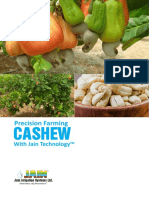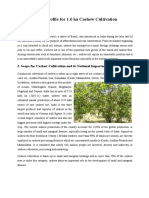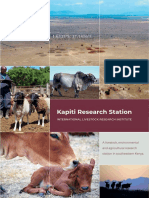Brachiaria Grass: New Forage Option For Sub-Saharan Africa: Contacts
Brachiaria Grass: New Forage Option For Sub-Saharan Africa: Contacts
Uploaded by
elinzolaCopyright:
Available Formats
Brachiaria Grass: New Forage Option For Sub-Saharan Africa: Contacts
Brachiaria Grass: New Forage Option For Sub-Saharan Africa: Contacts
Uploaded by
elinzolaOriginal Description:
Original Title
Copyright
Available Formats
Share this document
Did you find this document useful?
Is this content inappropriate?
Copyright:
Available Formats
Brachiaria Grass: New Forage Option For Sub-Saharan Africa: Contacts
Brachiaria Grass: New Forage Option For Sub-Saharan Africa: Contacts
Uploaded by
elinzolaCopyright:
Available Formats
AVCD Extension brief
Weed control Contacts
● Weed infestation is likely at early stages of the James Rao, ILRI
crop cultivation. Weeds should be removed
manually, but board-leaf weeds can be
AVCD dairy component coordinator
+254204223452; j.rao@cgiar.org
Brachiaria grass:
controlled with herbicide.
Pests and diseases
Sita Ghimire, ILRI New forage option for
Senior scientist, plant pathologist
● Red spider mites and shoot borers are the
common pests that attack Brachiaria grass.
+254204223820; s.ghimire@cgiar.org sub-Saharan Africa
● Some of the diseases observed in Kenya include
rust, ergot, smut and leaf spots.
Harvesting
● Brachiaria grass is suitable for both cut-and-
carry and grazing systems, and can be
conserved as hay and silage.
● The first crop is harvested four–five months
after planting by cutting at a height of 5 cm
above the ground.
● Subsequent harvest can made at very 8-12 weeks
depending on soil moisture and nutrients.
About AVCD
This material was produced on behalf of the Feed
the Future Kenya Accelerated Value Chain
Development (AVCD) program. This program
seeks to widely apply technologies and innovations
for four value chains—dairy, livestock, staple
drought tolerant crops and staple root crops—in
order to competitively and sustainably increase
productivity, contributing to inclusive agricultural
growth, nutrition and food security in the country.
The main goal of AVCD is to sustainably reduce
poverty and hunger in the Feed the Future zones of
influence in Kenya.
Focusing on the livestock, dairy, staple crops root
crops and staple drought tolerant crops value
chains in Kenya, AVCD aims to lift 317,000
households out of poverty, making them food
secure and enabling their transition from
subsistence to market-orientated farming. This publication is licensed for use under the Creative Commons Attribution 4.0 International Licence. June 2016
1. Introduction Establishment Rooted tillers
Brachiaria, a native African grass, is important ● Brachiaria can be established from seeds or rooted ● The Brachiaria tillers with roots can be used as
constituent of natural vegetation across sub- tillers (plant shoots) and stem cuttings with rooting planting materials. Two–three tillers are planted
Saharan Africa. Brachiaria grass consists of over nodes. on each hill at a spacing of 50 cm between
100 species but only four species are widely rows and 25 cm within the rows.
evaluated as cultivated pastures in tropical Africa. Photo 1: Brachiaria root splits ● Planting of rooted tillers should be performed at
It is the most extensively cultivated forage in onset of rainy season or transplant should be
South America, Australia and East Asia. irrigated for proper establishment.
However, the use of Brachiaria as cultivated ● A total of 64,000–96,000 tillers are required per acre.
forages in Africa is extremely limited.
Photo 3: Brachiaria nursery preparation
2. Benefits of brachiaria
Brachiaria grass produces a lot of nutritious
biomass (as much as 15 tonnes of dry matter per
acre/year), which in turn, when fed to livestock,
increases milk and meat production. Brachiaria is
drought tolerant and adapted to low fertility soils
of sub-Saharan Africa; it can play a significant role
in soil fertility improvement, soil conservation,
increasing bio-diversity and minimizing greenhouse
Seeds
gas emissions.
● Create shallow furrows (1–2 cm deep) spaced at 50
cm from the onset of rains.
3. Production environments ● To plant, continuously drill seeds along the furrows
● Brachiaria grows well in different agro- and cover with soil.
ecological zones of tropical Africa. It ● An acre of land requires 2–3 kg of good quality
performs best in sub-humid and humid seeds.
environments where rainfalls surpass 700 ● Alternatively, seeds can be first sown in nursery bed Varieties
mm and mean temperature exceeds 19°C. and seedlings transplanted to the main plots at the ● Brachiaria decumbens cv. Basilisk, B. brizantha cv. MG4,
● Lower temperatures slow down the growth age of six–eight weeks. B. brizantha cv. Piatã, and B. brizantha cv. Xaraés are the
rates, hence the Brachiaria grass performs ● In the nursery bed, seeds are sown in furrows best bet varieties for semi-arid, sub-humid and humid
poorly 1800 m above the sea level. spaced at 5 cm and mulched with dry grass. areas of Kenya and Rwanda.
● It grows on a wide range of soil types ● Brachiaria hybrid cv. Mulato II is suitable for
including those of low fertility. Photo 2: Brachiaria root split planting coastal low lands.
● Locations that experience longer dry seasons of
over five months are not suitable for Brachiaria, Manure and fertilizer
unless there is provision for irrigation. ● The pasture in the ‘cut-and-carry system’
removes substantial amount of soil nutrients.
4. Brachiaria production ● To maintain soil fertility, it is necessary to apply
Land preparation 2–4 tonnes of well-cured manure per acre.
● Plough, harrow and thoroughly mix soil with ● Brachiaria is highly responsive to nitrogen;
well cured manures at the rate of 2–4 application of 80 kg calcium ammonium nitrate
tonnes/acre. fertilizer per acre/season is advised.
● In cases where the soils are low in
phosphorus, it is advisable to apply 100 kg
triple super phosphate fertilizer per acre.
You might also like
- MAPATO Draft ConstitutionDocument8 pagesMAPATO Draft Constitutionelinzola81% (16)
- Bece Integrated Science Objective Questions and AnswersDocument63 pagesBece Integrated Science Objective Questions and AnswersBraa Frimpong100% (1)
- Raul Prebisch - Commercial Policy in The Underdeveloped Countries (1959)Document23 pagesRaul Prebisch - Commercial Policy in The Underdeveloped Countries (1959)guilmoura100% (1)
- Klages - 1928 - Crop Ecology and Ecological Crop Geography in The Agronomic CurriculumDocument18 pagesKlages - 1928 - Crop Ecology and Ecological Crop Geography in The Agronomic CurriculumAlejandra SahagúnNo ratings yet
- Edible NutsDocument209 pagesEdible Nutsalfa158955No ratings yet
- Review of Related Literature and StudiesDocument7 pagesReview of Related Literature and Studiesjirppy Esparaguera0% (1)
- How To Grow Brachiaria Grass: HarvestingDocument2 pagesHow To Grow Brachiaria Grass: HarvestingelinzolaNo ratings yet
- Variedades Criollas de Maíz (Zea Mays L.) en El Estado de Puebla, MéxicoDocument8 pagesVariedades Criollas de Maíz (Zea Mays L.) en El Estado de Puebla, MéxicoBaruch ChamorroNo ratings yet
- Fernando ChacelDocument8 pagesFernando ChacelcarloshnNo ratings yet
- Scientia Horticulturae: Patrick Du JardinDocument12 pagesScientia Horticulturae: Patrick Du JardinHector Chavez TeuberNo ratings yet
- Indigenous and Western Medicine in Colonial India (Z-Lib - Io)Document192 pagesIndigenous and Western Medicine in Colonial India (Z-Lib - Io)sarah shaikhNo ratings yet
- Nacho Simón MicroorganismosDocument100 pagesNacho Simón MicroorganismosGisela E. LópezNo ratings yet
- Instalaciones Agropecuarias. Fundamentos y Elementos de CálculoDocument3 pagesInstalaciones Agropecuarias. Fundamentos y Elementos de CálculoJoffre HerediaNo ratings yet
- Antropologia y Patrimonio PratzDocument85 pagesAntropologia y Patrimonio Pratzpavelbt100% (3)
- Konrad Lorenz Instinctive BehaviorDocument27 pagesKonrad Lorenz Instinctive BehavioredualmonNo ratings yet
- Gmelina Arborea: Verbenaceae RoxbDocument5 pagesGmelina Arborea: Verbenaceae RoxbHensim Mae CajesNo ratings yet
- Brachiaria Grass: Kenya National Farmers' FederationDocument4 pagesBrachiaria Grass: Kenya National Farmers' FederationelinzolaNo ratings yet
- Bajra Cultivation Techniology-Prof JAY G.varshneyDocument18 pagesBajra Cultivation Techniology-Prof JAY G.varshneyrishabhNo ratings yet
- Brachiaria Better Than Napier in PushDocument5 pagesBrachiaria Better Than Napier in Pushelinzola100% (1)
- Brochure BeetrootDocument2 pagesBrochure BeetrootluisalbertobizequeNo ratings yet
- Unit 4Document13 pagesUnit 4Bishnu Prasad PattnaikNo ratings yet
- Brochure CabbageDocument2 pagesBrochure CabbageLucky GojeNo ratings yet
- Ricebean High Valued Fodder CropDocument6 pagesRicebean High Valued Fodder CropCris BaggeoNo ratings yet
- Report of Pasture EstablishmentDocument23 pagesReport of Pasture EstablishmentFART TVNo ratings yet
- Wheat Production PptDocument23 pagesWheat Production Pptjack oumaNo ratings yet
- Report of Pasture Establishment 1234Document29 pagesReport of Pasture Establishment 1234FART TVNo ratings yet
- Agriculture _ Short Notes ~ (SST)Document4 pagesAgriculture _ Short Notes ~ (SST)ranjeetamalviya007No ratings yet
- Fodder Production Poster MucunaDocument1 pageFodder Production Poster MucunaKennedy NgonidzaIshe KanguruNo ratings yet
- MAIZE Production GuideDocument8 pagesMAIZE Production GuidePatrick ChilesheNo ratings yet
- Rice Crop CultivationDocument15 pagesRice Crop CultivationNuur Yusuf Sheikh OmarNo ratings yet
- Cardamom: Precision FarmingDocument8 pagesCardamom: Precision Farminganupem4uNo ratings yet
- Gliricidia Sepium FactsheetDocument4 pagesGliricidia Sepium FactsheetJapachumi JaguaNo ratings yet
- Control of Brachiaria Arrecta in A Wet Environment - 2Document7 pagesControl of Brachiaria Arrecta in A Wet Environment - 2Nilamdeen Mohamed ZamilNo ratings yet
- Planting Guide For Hybrid RiceDocument2 pagesPlanting Guide For Hybrid RiceGIEBON QUIROSNo ratings yet
- Cultivation of Sorghum For GrainDocument33 pagesCultivation of Sorghum For GrainAditya DagarNo ratings yet
- Mulbery Cultivation in SericultureDocument9 pagesMulbery Cultivation in SericulturehaseameyNo ratings yet
- 11 Khejri A Wonder Tree For Nutritional ValueDocument4 pages11 Khejri A Wonder Tree For Nutritional ValueRiaz MunshiNo ratings yet
- Castor: Ricinus Communis LDocument8 pagesCastor: Ricinus Communis Ldevrajsinhchauhan8055No ratings yet
- RagiDocument6 pagesRagiAshwini AshwiniNo ratings yet
- Rice Straw Its Production and Utilization in Indi-Wageningen University and Research 333859Document13 pagesRice Straw Its Production and Utilization in Indi-Wageningen University and Research 333859ceerno9No ratings yet
- Asam Cereal Crop Pearl MilletDocument26 pagesAsam Cereal Crop Pearl MilletX IntērNo ratings yet
- Cultivation of Sweet Potato Ipomea Batat PDFDocument2 pagesCultivation of Sweet Potato Ipomea Batat PDFIoana Johanna IancuNo ratings yet
- Crops DBDocument8 pagesCrops DBPankaj GorleNo ratings yet
- black gram cultivation methodDocument2 pagesblack gram cultivation methodseetu balharaNo ratings yet
- Smuts Finger GrassDocument4 pagesSmuts Finger Grassenock chirigaNo ratings yet
- Rabi Maize in RajasthanDocument2 pagesRabi Maize in Rajasthanvishal kalasuaNo ratings yet
- Varietal Seed Production of SorghumDocument6 pagesVarietal Seed Production of SorghumOmkar samantNo ratings yet
- Safed MusliDocument6 pagesSafed MusliChaitanya KumarNo ratings yet
- Tof Magazine January 2021 IssueDocument8 pagesTof Magazine January 2021 Issuemohamed adamNo ratings yet
- AGRICULTUREDocument6 pagesAGRICULTUREUNKNOWNajaNo ratings yet
- Cashew UHDPDocument9 pagesCashew UHDPTojiNo ratings yet
- Ground Nut: Common NameDocument7 pagesGround Nut: Common NameSoumayadeep BasakNo ratings yet
- 222222222222222Document58 pages222222222222222biradarrameshwarNo ratings yet
- NRM 123 lecture 5 wheat maize sorghumDocument16 pagesNRM 123 lecture 5 wheat maize sorghumSunil Kumar ChongthamNo ratings yet
- Common ForagesDocument4 pagesCommon ForagesLeonel James SuraltaNo ratings yet
- The Pearl Millet - BAJRADocument17 pagesThe Pearl Millet - BAJRADnyanu KordiyaNo ratings yet
- Planting Guide For Hybrid RiceDocument2 pagesPlanting Guide For Hybrid RiceRommel SacramentoNo ratings yet
- Rhodes Grass X Tozi FactsheetDocument3 pagesRhodes Grass X Tozi FactsheettajwalisultanNo ratings yet
- CottonDocument5 pagesCottonBhushan ChardeNo ratings yet
- SorghumDocument4 pagesSorghumطه عبد الوهاب خميسNo ratings yet
- Chapter - Iv Sugarcane Cultivation in IndiaDocument47 pagesChapter - Iv Sugarcane Cultivation in IndiaHimanshu MogheNo ratings yet
- 10969-NARI Guyana Culture Et Post-Récolte de Manioc (Angl)Document17 pages10969-NARI Guyana Culture Et Post-Récolte de Manioc (Angl)simbeyefranklin44No ratings yet
- Cashewnut CultivationDocument14 pagesCashewnut CultivationraviprasadslnNo ratings yet
- Grant Thornton Alert - The Finance Bill 2020Document10 pagesGrant Thornton Alert - The Finance Bill 2020elinzolaNo ratings yet
- CSE Guide - Standalone Solar System PDFDocument8 pagesCSE Guide - Standalone Solar System PDFelinzolaNo ratings yet
- Credit Guarantee For AgricDocument124 pagesCredit Guarantee For AgricelinzolaNo ratings yet
- Best Practice Hanbook On Performance EvalutionDocument258 pagesBest Practice Hanbook On Performance Evalutionelinzola100% (1)
- M-Akiba Post Issuance Survey: Report - June 2018Document32 pagesM-Akiba Post Issuance Survey: Report - June 2018elinzolaNo ratings yet
- 15.4.2018 Coffee General Regulations 2018 19.4.2018 PDF VERSIONDocument71 pages15.4.2018 Coffee General Regulations 2018 19.4.2018 PDF VERSIONelinzolaNo ratings yet
- The Dairy Industry Act: Legal Notice NoDocument3 pagesThe Dairy Industry Act: Legal Notice NoelinzolaNo ratings yet
- The Dairy Industry Act: RegulationDocument5 pagesThe Dairy Industry Act: RegulationelinzolaNo ratings yet
- The Dairy Industry (Dairy Produce Safety) Regulations, 2020Document32 pagesThe Dairy Industry (Dairy Produce Safety) Regulations, 2020elinzola100% (2)
- The Dairy Industry Act: RegulationDocument6 pagesThe Dairy Industry Act: RegulationelinzolaNo ratings yet
- The Dairy Industry (Dairy Inspector) Regulations, 2020Document11 pagesThe Dairy Industry (Dairy Inspector) Regulations, 2020elinzolaNo ratings yet
- The Dairy Industry Act: RegulationDocument5 pagesThe Dairy Industry Act: RegulationelinzolaNo ratings yet
- 1st ISC PresentationDocument19 pages1st ISC PresentationelinzolaNo ratings yet
- The Dairy Industry Act: RegulationDocument17 pagesThe Dairy Industry Act: RegulationelinzolaNo ratings yet
- Green Infrastructure For The Coast: A Primer For Local Decision MakingDocument52 pagesGreen Infrastructure For The Coast: A Primer For Local Decision MakingelinzolaNo ratings yet
- Brachiaria Grass: Kenya National Farmers' FederationDocument4 pagesBrachiaria Grass: Kenya National Farmers' FederationelinzolaNo ratings yet
- County Governments Procurement Regulations 2013 PDFDocument6 pagesCounty Governments Procurement Regulations 2013 PDFelinzolaNo ratings yet
- Legal Notice No . The Dairy Industry Act: RegulationDocument10 pagesLegal Notice No . The Dairy Industry Act: Regulationelinzola100% (1)
- Brachiaria Better Than Napier in PushDocument5 pagesBrachiaria Better Than Napier in Pushelinzola100% (1)
- Kapiti Research Station: International Livestock Research InstituteDocument12 pagesKapiti Research Station: International Livestock Research InstituteelinzolaNo ratings yet
- KVDA Strategic Plan PDFDocument65 pagesKVDA Strategic Plan PDFelinzolaNo ratings yet
- Coconut Census Report PDFDocument87 pagesCoconut Census Report PDFelinzola100% (8)
- Appellate Jurisdiction Act (Cap. 9)Document75 pagesAppellate Jurisdiction Act (Cap. 9)elinzolaNo ratings yet
- Machakos Budget 2013 2014 PDFDocument13 pagesMachakos Budget 2013 2014 PDFelinzolaNo ratings yet
- GerberaDocument17 pagesGerberakashyapatel5998No ratings yet
- Arabian Journal of Chemistry Volume 7 Issue 1 2014 (Doi 10.1016/j.arabjc.2013.10.007) Rahman, Md. Mukhlesu PDFDocument17 pagesArabian Journal of Chemistry Volume 7 Issue 1 2014 (Doi 10.1016/j.arabjc.2013.10.007) Rahman, Md. Mukhlesu PDFDesiana NurulhNo ratings yet
- Week 1Document16 pagesWeek 1wr6258681No ratings yet
- NPK Questionnaire 15 - AppendixDocument7 pagesNPK Questionnaire 15 - AppendixSX100% (1)
- ReportDocument70 pagesReportmr copy xeroxNo ratings yet
- Final ProjectDocument80 pagesFinal ProjectLASSANANo ratings yet
- Research PlanDocument8 pagesResearch PlanShirleyTse04No ratings yet
- Organic Carrots: Production Guide For For ProcessingDocument31 pagesOrganic Carrots: Production Guide For For ProcessingJuan M Garcia Conde100% (1)
- Technology and Livelihood EducationDocument46 pagesTechnology and Livelihood EducationMayly A. MontañezNo ratings yet
- 8 - Edible Landscape DesignDocument66 pages8 - Edible Landscape DesignMehmet EvliyaNo ratings yet
- June Magazine 2016Document24 pagesJune Magazine 2016Harshit Pant 30No ratings yet
- Organic Certification RequirementsDocument13 pagesOrganic Certification RequirementsMerga BeyeneNo ratings yet
- DO THIS NOW Fermented Plant Juice Can Also Provide Vitamins and Probiotics - Agriculture MonthlyDocument6 pagesDO THIS NOW Fermented Plant Juice Can Also Provide Vitamins and Probiotics - Agriculture MonthlyTrxtr GiananNo ratings yet
- Simplified Hydroponics - Not ViableDocument3 pagesSimplified Hydroponics - Not ViablevsatsangaNo ratings yet
- Good Agricultural Practices For More Resilient AgricultureDocument73 pagesGood Agricultural Practices For More Resilient AgricultureRigo LCNo ratings yet
- CROP & FERTILIZER RECOMANDATION SYSTEM USING MLDocument51 pagesCROP & FERTILIZER RECOMANDATION SYSTEM USING MLmalik cpNo ratings yet
- 3.3 Plant Disease QP (Separate Only)Document26 pages3.3 Plant Disease QP (Separate Only)Gbenga AjibikeNo ratings yet
- A Report On Agriculture Industry in India: Submitted by Harshit GuptaDocument26 pagesA Report On Agriculture Industry in India: Submitted by Harshit GuptaAnimesh SoniNo ratings yet
- A Comparative Analysis MungbeanDocument3 pagesA Comparative Analysis Mungbeanncplagumbay00130No ratings yet
- Comparisons of Manure, Compost, and Commercial FertilizersDocument25 pagesComparisons of Manure, Compost, and Commercial FertilizersAditya Gatadi KhandobaNo ratings yet
- Research Grade 9Document40 pagesResearch Grade 9Super MaxNo ratings yet
- IFFCODocument54 pagesIFFCOPriyanka Sharma67% (3)
- Farms and Food WorksheetDocument2 pagesFarms and Food WorksheetAsma Assouma100% (1)
- 1.0 Green Beans 1.1 BackgroundDocument9 pages1.0 Green Beans 1.1 Backgroundmontel mukachanaNo ratings yet
- Your Plants: Deserve The BestDocument4 pagesYour Plants: Deserve The Bestbader_222_joNo ratings yet
- Seed Cum Fertilizer Broadcasting MachineDocument22 pagesSeed Cum Fertilizer Broadcasting MachineMuktadirNo ratings yet
- Operations Report-PAKARAB FertilizersDocument27 pagesOperations Report-PAKARAB Fertilizersiqrakhan007100% (6)
- TLE-TE 6 - Q1 - Mod6 - Agriculture Edited2Document23 pagesTLE-TE 6 - Q1 - Mod6 - Agriculture Edited2Charlie Ferrer EstradaNo ratings yet
















































































































